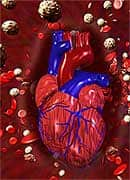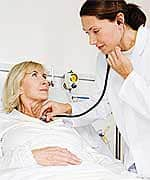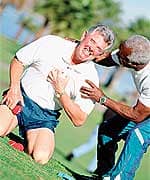Life Extension Magazine®
After a heart attack, there is a limited window of time to restore cellular energy production. Failure to rejuvenate blood-deprived cardiac cells results in catastrophic heart muscle damage. New studies reveal how a low-cost nutrient can protect against cell damage that occurs during a heart attack and help rejuvenate heart muscles that have suffered injuries from previous ischemic (no blood flow) events.1 Supporting “Cardiac Rejuvenation”Cardiologists are slowly recognizing specific nutrients play a vital role in preventing and treating heart disease—particularly ischemic heart disease (caused by coronary artery occlusion) that underlies most heart attacks. When deprived of blood flow, the injured heart muscle becomes flabby and unable to pump blood efficiently.
The sharp drop in ATP (adenosine triphosphate) levels experienced by heart muscle cells during the obstruction of blood flow, and the long delay in restoring those levels to normal even after blood flow returns is critically important after a heart attack. This so-called ischemia-reperfusion injury is now known to be the major culprit that produces long-term heart damage in survivors of heart attacks, rendering tissue inordinately vulnerable to free-radical damage produced by the oxygen-rich (yet life-saving) re-flow of blood into the injured area.2-4 In fact, one researcher this year referred to the heart mitochondria (the site of all that ATP production) as “the gates of life and death!”5 Clearly, helping heart muscle cells to recover rapidly from a cardiac event is a major priority in preventing long-term damage. A natural ingredient for building new ATP, D-ribose is an important component of a “cardiac rejuvenation” regimen. Animal studies show that it dramatically increases ATP levels in the critical reperfusion period after a heart attack (the time when blood flow is restored and cells use energy at extremely high levels to repair the damage). This provides much-needed energy levels to block further injury and start the healing process.6-8 A landmark interventional study demonstrated these effects dramatically.9 The cardiac arrest induced during certain kinds of heart surgery (such as bypass surgery) causes heart muscle function to deteriorate quickly, even in relatively healthy areas of the heart, an effect that is associated with low ATP levels, which can severely delay recovery following surgery. As a result, the scientists administered D-ribose to the heart during surgery, reasoning that they could “stoke up” heart muscle in advance with the necessary ingredients for ATP. This procedure produced dramatic results in the experimental study consisting of a full hour of cardiac arrest. The ribose-supplemented experimental group showed significant improvement in heart muscle function compared with controls—and the amount of improvement correlated directly with the quantity of ATP in the heart muscle!9 Since then, convincing evidence has continued to accumulate that D-ribose directly contributes to the rejuvenation of injured heart muscle.10-13 In essence, these studies established the powerful protective effect of D-ribose and other ATP components under the most stressful situation heart muscle can encounter—complete cessation of blood flow followed by sudden return of oxygen-carrying blood. Rejuvenating Human HeartsSome exciting studies have emerged showing how D-ribose affects active human heart tissue and its function.14,15 Investigators have shown how increased ATP levels translate into improved heart muscle function, better blood flow, and quicker recovery with protection from the ravages of reperfusion-induced oxidation. Ischemic (no blood flow) events such as a heart attack cause areas of the heart muscle to “hibernate” exactly as if they were awaiting a higher-energy environment to return to their normal rates of activity. Cardiologists at the Oregon Health Sciences
University studied this phenomenon in a group of patients with coronary artery disease, subjecting them to a “thallium stress test.”16 In this test, patients are injected with a radioactive tracer immediately following moderate exercise, and the distribution of the tracer is followed using special cameras. The patients received either D-ribose infusion or a placebo and the tests were repeated at four and 24 hours, respectively. The groups were then switched to receive the opposite preparation. The results were stunning—the images taken just four hours after D-ribose infusion revealed 21 areas of defective tissue that had not been seen in the placebo group, indicating that D-ribose was “waking up” viable areas of heart muscle and helping improve identification of viable ischemic heart muscle.16 A larger study published the same year showed similar results.17 These studies show that D-ribose not only enhances cardiologists’ ability to accurately gauge the degree of heart damage, but also suggest strongly that this supplement might hasten the recovery of healthy heart function following a heart attack. CardioprotectionSurvivors of heart attacks face the prospects of permanently damaged heart muscle, which saps the heart’s pumping abilities and produces a host of symptoms from mild exercise intolerance to severe congestive heart failure. And since rehabilitation for practically any heart condition requires regular moderate exercise, it is vital to assure that heart muscle cells optimize ATP levels. A problem aging humans face is that their heart muscle enlarges and becomes “stiff.” The result of this enlargement is a reduction in ability to contract to pump blood out and to relax to allow blood in. People with ventricular hypertrophy often have limited exercise tolerance and their hearts are often especially vulnerable to ischemia and subsequent further damage.
In a study with far-reaching implications for humans, researchers examined the effects of D-ribose in animals to determine whether the supplement, given in advance, could protect their hearts against experimentally induced ischemia.18 They also studied the effects of D-ribose in animals with hypertension and enlarged heart muscles, the same hypertrophy that so commonly develops in humans with sustained high blood pressure. The first study results were stunning. The heart muscles of healthy animals given D-ribose before ischemia held out 25% longer before the onset of irreversible injury and had significantly elevated stores of energy-rich glycogen. In human terms, that could translate into valuable extra time for modern emergency medical services to do their part, and could result in dramatically improved survival after stabilization. These researchers also showed that in the hypertensive rats with ventricular hypertrophy, D-ribose treatment significantly improved ventricular function by as much as 25%, increasing the hearts’ ability to “squeeze” at the appropriate times and pumping blood more effectively. The translation for humans? Similar results would allow those with ailing hearts to deliver more blood to vital energy-hungry body organs and structures—including the skeletal muscles that so readily fatigue and limit exercise tolerance.
Protecting Patients with Heart DiseaseThe results of these studies also have strong implications for the benefits of D-ribose in protecting people with congestive heart failure, who just don’t have the cardiac power to pump blood vigorously from their hearts and around the body. The result is often lack of energy, poor exercise tolerance and, in more severe cases, liver and lung complications, which can ultimately be fatal. Restoring the heart muscle’s “tone” in patients with congestive heart failure is the goal of a host of drug treatments including diuretics, digoxin, and others. In 2003, German researchers, however, took a more natural approach—they provided daily oral D-ribose supplements or placebo for three weeks to 15 people with congestive heart failure.19 The groups then reversed their treatment assignments. During the period of D-ribose supplementation, the patients showed dramatic improvements in their hearts’ ability to fill and empty efficiently—changes critical to reducing fluid accumulation throughout the body, and to boosting energy levels as tissues gain oxygen and nutrients from the restored blood flow. Perhaps most importantly from the patients’ own standpoint, they reported substantial improvements in quality of life while on the active supplement. This general sense of improved energy and well-being is vital to reinvigorating people and getting them started on making the lifestyle changes (such as increased exercise) that we know are so important to maintaining cardiovascular health. This study followed an earlier publication of a seminal paper by German cardiologists who studied the effect of D-ribose in 20 men with severe coronary artery disease that was sharply limiting their exercise tolerance (the ability to engage in mild physical activity without either painful symptoms or ominous changes in electrocardiogram [EKG] tracings).20 The researchers tested the men with two treadmill exercise tolerance tests to determine their baseline level of physical function. Subjects were then randomly assigned to receive either D-ribose 60 grams/ day by mouth or a placebo for three days. Next, the exercise tolerance tests were repeated, with the subjects walking until EKG changes mandated a halt. Men who had taken the supplement were able to increase their treadmill walking time to 4.6 minutes, compared with just 3.7 minutes in the control group—a 24% improvement. The ribose-supplemented men also showed a significant improvement in the time it took to develop moderate angina (chest pain) compared with their baseline times—a change that the control group did not experience. This study provided another way to promote heart function in people with significant cardiac disease. Of course had these same patients been given ubiquinol CoQ10, acetyl-l-carnitine, taurine, and other cardiac-energizing nutrients, even greater improvements may have been observed, or a lower dose of D-ribose needed. Energizing Skeletal Muscle“Cardiac rejuvenation” is clearly one of the important ways in which D-ribose can produce benefits for people with heart problems. But what about the all-important skeletal muscles that are called on to actually use the energy supplied by that increased blood flow and improved sense of well-being? There’s good news on that front as well, as a series of remarkable studies has shown. A regular exercise program is critical to prevention of cardiovascular disease, as well as to the all-important rehabilitation following a heart attack, stroke, or other potentially catastrophic event.21,22 Yet fewer than 50% of patients at risk actually participate in regular, structured exercise programs aimed at improving or maintaining cardiovascular health.23 Many people simply have trouble mustering the energy they need to start and maintain even a modest program of physical activity. One study found that exercise-induced physical fatigue was the most important reason people stopped their workouts.24 That’s understandable —vigorous exercise can drop muscle ATP levels by up to 20%, with up to a 72-hour recovery period being required when muscles have been worked hard.25,26 The “wiped-out” feeling many of us experience after exercise is also caused by the leakage of ATP breakdown products from muscles into the bloodstream.27 And though personal trainers love to chant “no pain, no gain,” the truth is that too much pain can lead to no gain at all! Once again, D-ribose is vital to keeping our muscles’ ATP-based energy stores at peak capacity.28,29 And that can mean less “afterburn” and more enthusiasm for the next workout. There’s excellent science to back up the idea that D-ribose is good for working muscles. Exercise physiologists showed that supplementing the muscles with D-ribose increased the total amount of ATP produced by up to four-fold, providing a substantial “bank” of energy that could be called on for use when needed.30 And when physiologists in Missouri provided D-ribose to working muscles, they demonstrated as much as a six-fold rise in the rate at which ATP components were recycled for use (recycling ATP is much faster and more efficient than building it from scratch).29,31 Danish sports and exercise physiologists showed that human muscle lost ATP after extreme exercise just like in experimental models and they also noted that the exhausted muscles took longer to replenish their ATP levels than rested muscles.27 That led them to speculate that supplementing human sprinters with D-ribose might speed the recovery of their muscles’ ATP levels. In 2004, they published a landmark paper showing that, in fact, three-times daily supplements of D-ribose for three days following extreme sprint training caused ATP levels to return to normal within 72 hours, while in placebo recipients ATP levels remained depressed.32 It is important to note here that in this study as well as in many others, the D-ribose supplements did not increase muscle strength or power.33-37 So don’t think of D-ribose as a “strength-training” supplement. The restoration of normal ATP levels in “worked-out” muscles is probably what reduces the “wiped-out,” “spongy,” or “burning” feelings that people often experience following a workout.
Word of CautionNumerous human studies have shown that intravenous infusion or high-dose oral supplementation with D-ribose produces hypoglycemic (blood sugar-lowering) effects.32,38,39 This effect seems to be dose-related, with larger doses producing greater declines in blood glucose. Taking D-ribose with meals may help offset its hypoglycemic effect. SummaryFor millennia, people have believed that as we age, we naturally lose energy and vitality, but increasingly we’re learning that those losses are not inevitable. Humans, like all living things, must maintain high levels of ATP to support physical activity, and damaged or stressed muscle is slower at restoring those critical levels back to normal. And when ATP levels drop and cannot be restored quickly, we do indeed feel “drained” of energy. But remarkable scientific progress has been made in the past few decades. Scientists are discovering that simply by providing injured, ailing, or fatigued muscle tissue with the ingredients for ATP, that tissue can be “rejuvenated,” restoring energy levels and boosting function. D-ribose, a natural sugar molecule with no known side effects, is one of those key ingredients. D-ribose supplementation powers damaged heart muscle back to near-normal levels of function, allowing victims of cardiovascular disease to begin the vital rehabilitation process. D-ribose can also help restore ATP levels in skeletal muscle, relieving pain and weakness post-exercise, and helping people to actually maintain the moderate level of increased exercise that is so critical to preventing heart disease and to recovering from it if it does occur. D-ribose can improve both cardiac energy and quality of life—a winning combination! If you have any questions on the scientific content of this article, please call a Life Extension Health Advisor at 1-800-226-2370.
| ||||||||||||||||||||||||
| References | ||||||||||||||||||||||||
| 1. Sinatra ST, Roberts JC. Enhancing cardiac energy with ribose. Life Extension. 2007 May;13(50):26-31. 2. Gao L, Laude K, Cai H. Mitochondrial Pathophysiology, Reactive Oxygen Species, and Cardiovascular Diseases. Vet Clin North Am Small Anim Pract. 2008 Jan;38(1):137-55. 3. Kumar D, Lou H, Singal PK. Oxidative stress and apoptosis in heart dysfunction. Herz. 2002 Nov;27(7):662-8. 4. Sorescu D, Griendling KK. Reactive oxygen species, mitochondria, and NAD(P)H oxidases in the development and progression of heart failure. Congest Heart Fail. 2002 May;8(3):132-40. 5. Gustafsson AB, Gottlieb RA. Heart mitochondria: gates of life and death. Cardiovasc. 2008 Feb 1;77(2):334-43. 6. Zimmer HG, Ibel H. Ribose accelerates the repletion of the ATP pool during recovery from reversible ischemia of the rat myocardium. J Mol Cell Cardiol. 1984 Sep;16(9):863-6. 7. St Cyr JA, Bianco RW, Schneider JR, et al. Enhanced high energy phosphate recovery with ribose infusion after global myocardial ischemia in a canine model. J Surg Res. 1989 Feb;46(2):157-62. 8. Ward HB, Wang T, Einzig S, Bianco RW, Foker JE. Prevention of ATP catabolism during myocardial ischemia: a preliminary report. J Surg Res. 1983 Apr;34(4):292-7. 9. Wyatt DA, Ely SW, Lasley RD, et al. Purine-enriched asanguineous cardioplegia retards adenosine triphosphate degradation during ischemia and improves postischemic ventricular function. J Thorac Cardiovasc Surg. 1989 May;97(5):771-8. 10. Smolenski RT, Raisky O, Slominska EM, et al. Protection from reperfusion injury after cardiac transplantation by inhibition of adenosine metabolism and nucleotide precursor supply. Circulation. 2001 Sep 18;104(12 Suppl 1):I246-52. 11. Zimmer HG, Martius PA, Marschner G. Myocardial infarction in rats: effects of metabolic and pharmacologic interventions. Basic Res Cardiol. 1989 May;84(3):332-43. 12. Thirunavukkarasu M, Penumathsa S, Juhasz B, et al. Enhanced cardiovascular function and energy level by a novel chromium (III)-supplement. Biofactors. 2006;27(1-4):53-67. 13. Thirunavukkarasu M, Penumathsa SV, Juhasz B, et al. Niacin-bound chromium enhances myocardial protection from ischemia-reperfusion injury. Am J Physiol Heart Circ Physiol. 2006 Aug;291(2):H820-6. 14. Pauly DF, Pepine CJ. Ischemic heart disease: metabolic approaches to management. Clin Cardiol. 2004 Aug;27(8):439-41. 15. Pauly DF, Johnson C, St Cyr JA. The benefits of ribose in cardiovascular disease. Med Hypotheses. 2003 Feb;60(2):149-51. 16. Hegewald MG, Palac RT, Angello DA, Perlmutter NS, Wilson RA. Ribose infusion accelerates thallium redistribution with early imaging compared with late 24-hour imaging without ribose. J Am Coll Cardiol. 1991 Dec;18(7):1671-81. 17. Perlmutter NS, Wilson RA, Angello DA, et al. Ribose facilitates thallium-201 redistribution in patients with coronary artery disease. J Nucl Med. 1991 Feb;32(2):193-200. 18. Wallen WJ, Belanger MP, Wittnich C. Preischemic administration of ribose to delay the onset of irreversible ischemic injury and improve function: studies in normal and hypertrophied hearts. Can J Physiol Pharmacol. 2003 Jan;81(1):40-7. 19. Omran H, Illien S, MacCarter D, St CJ, Luderitz B. D-Ribose improves diastolic function and quality of life in congestive heart failure patients: a prospective feasibility study. Eur J Heart Fail. 2003 Oct;5(5):615-9. 20. Pliml W, von AT, Stablein A, et al. Effects of ribose on exercise-induced ischaemia in stable coronary artery disease. Lancet. 1992 Aug 29;340(8818):507-10. 21. Choo J, Burke LE, Pyo HK. Improved quality of life with cardiac rehabilitation for post-myocardial infarction patients in Korea. Eur J Cardiovasc Nurs. 2007 Sep;6(3):166-71. 22. Ades PA. Individualized preventive care in cardiac rehabilitation: adapted from AACVPR Award of Excellence Lecture, Charleston, WVa, October, 2006. J Cardiopulm Rehabil Prev. 2007 May;27(3):130-4. 23. Moore SM, Dolansky MA, Ruland CM, Pashkow FJ, Blackburn GG. Predictors of women’s exercise maintenance after cardiac rehabilitation. J Cardiopulm Rehabil. 2003 Jan;23(1):40-9. 24. Annesi J. Relations of self-motivation, perceived physical condition, and exercise-induced changes in revitalization and exhaustion with attendance in women initiating a moderate cardiovascular exercise regimen. Women Health. 2005;42(3):77-93. 25. Hellsten-Westing Y, Norman B, Balsom PD, Sjodin B. Decreased resting levels of adenine nucleotides in human skeletal muscle after high-intensity training. J Appl Physiol. 1993 May;74(5):2523-8. 26. Stathis CG, Febbraio MA, Carey MF, Snow RJ. Influence of sprint training on human skeletal muscle purine nucleotide metabolism. J Appl Physiol. 1994 Apr;76(4):1802-9. 27. Hellsten Y, Richter EA, Kiens B, Bangsbo J. AMP deamination and purine exchange in human skeletal muscle during and after intense exercise. J Physiol. 1999 Nov 1;520 Pt 3:909-20. 28. Tullson PC, John-Alder HB, Hood DA, Terjung RL. De novo synthesis of adenine nucleotides in different skeletal muscle fiber types. Am J Physiol. 1988 Sep;255(3 Pt 1):C271-7. 29. Zarzeczny R, Brault JJ, Abraham KA, Hancock CR, Terjung RL. Influence of ribose on adenine salvage after intense muscle contractions. J Appl Physiol. 2001 Oct;91(4):1775-81. 30. Tullson PC, Terjung RL. Adenine nucleotide synthesis in exercising and endurance-trained skeletal muscle. Am.J Physiol. 1991 Aug;261(2 Pt 1):C342-7. 31. Brault JJ, Terjung RL. Purine salvage to adenine nucleotides in different skeletal muscle fiber types. J Appl Physiol. 2001 Jul;91(1):231-8. 32. Hellsten Y, Skadhauge L, Bangsbo J. Effect of ribose supplementation on resynthesis of adenine nucleotides after intense intermittent training in humans. Am J Physiol Regul Integr Comp Physiol. 2004 Jan;286(1):R182-8. 33. Berardi JM, Ziegenfuss TN. Effects of ribose supplementation on repeated sprint performance in men. J Strength Cond Res. 2003 Feb;17(1):47-52. 34. Dunne L, Worley S, Macknin M. Ribose versus dextrose supplementation, association with rowing performance: a double-blind study. Clin J Sport Med. 2006 Jan;16(1):68-71. 35. Kerksick C, Rasmussen C, Bowden R, et al. Effects of ribose supplementation prior to and during intense exercise on anaerobic capacity and metabolic markers. Int J Sport Nutr Exerc Metab. 2005 Dec;15(6):653-64. 36. Op ‘t EB, Van LM, Brouns F, et al. No effects of oral ribose supplementation on repeated maximal exercise and de novo ATP resynthesis. J Appl Physiol. 2001 Nov;91(5):2275-81. 37. Peveler WW, Bishop PA, Whitehorn EJ. Effects of ribose as an ergogenic aid. J Strength Cond Res. 2006 Aug;20(3):519-22. 38. Segal S, Foley J, Wyngaarden JB. Hypoglycemic effect of D-ribose in man. Proc Soc Exp Biol Med. 1957 Jul;95(3):551-5. 39. Gross M, Reiter S, Zollner N. Metabolism of D-ribose administered continuously to healthy persons and to patients with myoadenylate deaminase deficiency. Klin Wochenschr. 1989 Dec 4;67(23):1205-13. 40. Dimroth P, von BC, Meier T. Catalytic and mechanical cycles in F-ATP synthases. Fourth in the Cycles Review Series. EMBO Rep. 2006 Mar;7(3):276-82. 41. Jain M, Cui L, Brenner DA, et al. Increased myocardial dysfunction after ischemia-reperfusion in mice lacking glucose-6-phosphate dehydrogenase. Circulation. 2004 Feb 24;109(7):898-903. 42. Pacher P, Szabo C. Role of poly(ADP-ribose) polymerase 1 (PARP-1) in cardiovascular diseases: the therapeutic potential of PARP inhibitors. Cardiovasc Drug Rev. 2007;25(3):235-60. 43. Zimmer HG. The oxidative pentose phosphate pathway in the heart: regulation, physiological significance, and clinical implications. Basic Res Cardiol. 1992 Jul;87(4):303-16. 44. Zimmer HG. Regulation of and intervention into the oxidative pentose phosphate pathway and adenine nucleotide metabolism in the heart. Mol Cell Biochem. 1996 Jul;160-161:101-9. 45. Clay MA, Stewart-Richardson P, Tasset DM, Williams JF. Chronic alcoholic cardiomyopathy. Protection of the isolated ischaemic working heart by ribose. Biochem Int. 1988 Nov;17(5):791-800. 46. Parang P, Singh B, Arora R. Metabolic modulators for chronic cardiac ischemia. J Cardiovasc Pharmacol Ther. 2005 Dec;10(4):217-23. 47. Pauly DF, Pepine CJ. D-Ribose as a supplement for cardiac energy metabolism. J Cardiovasc Pharmacol Ther. 2000 Oct;5(4):249-58. 48. Kendler BS. Supplemental conditionally essential nutrients in cardiovascular disease therapy. J Cardiovasc Nurs. 2006 Jan;21(1):9-16. 49. Lamberts RR, Caldenhoven E, Lansink M, et al. Preservation of diastolic function in monocrotaline-induced right ventricular hypertrophy in rats. Am J Physiol Heart Circ Physiol. 2007;293:H1869-H1876. 50. Teitelbaum JE, Johnson C, St CJ. The use of D-ribose in chronic fatigue syndrome and fibromyalgia: a pilot study. J Altern Complement Med. 2006;12:857-62. |





